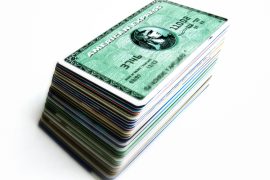I’m no big world traveler. So when faced with the prospect of filling an entire month with travel-related blog posts, I reached out to more experienced folks. Fellow freelance writer, Beth Hughes offered to write this post, detailing how she’s able to hop the globe on a limited budget. While there’s not a lot of hard math here, she does share a really smart estimation tip that helps her keep cash in her wallet–for her next trip. And you can definitely see how a little bit of planning and observation adds up to big savings. So, welcome Beth!
When I travel, I usually head to pricey places like Japan, Hong Kong and Hawaii. Yet I’ve figured out how to make these trips without breaking the bank, even when the dollar is weak. The key is planning, observing, and a little mental trickery.
Before you go
Use a travel agent. Because I usually travel with a friend, my agent, Julie Sturgeon of Curing Cold Feet, creates custom group packages for us. Savings on our last 10-day jaunt to Hawaii were about $20 each, or a tank of gas. Some years, she saves us twice that. Savings: $20-$40
Decide how connected you must be. Free WiFi is not ubiquitous. Select a hotel with free WiFi so you can stay in touch via email and Skype if you have a smartphone or other device. Savings: up to $20 per day
Make sure you select a hotel that equips the rooms with an electric kettle and a refrigerator. Pack food for your arrival if you’re getting in late–small cans of pop-top tuna, packs of instant oatmeal, a little jar of peanut butter and some crackers. Pack coffee or tea, and any equipment for preparing it. Savings: about $10 per day
Research the fees your bank’s ATM network, what it charges for ATM withdrawals and what service fee it tacks onto credit card purchases outside the United States. Your goal is to reduce the fee burden by withdrawing enough cash from an affiliated ATM to cover anticipated expenses for five or six days. You get a better exchange rate than you do at a moneychanger. In Tokyo recently, the airport moneychanger offered ¥71 for each US$1 while an affiliated bank’s ATM gave me ¥78. Stash the extra cash in your hotel room safe. Avoid using your credit card for a cash advance. The interest rates are punishing. Savings: up to $25
Upon Arrival
Buy a SIM card with the least expensive international call and data plan that you can top off online using a credit card. (In Japan, tourists must rent SIM cards.) The SIM card will be valid for as long as six months. You will probably leave money behind but compared with international roaming charges, it’s less than a pittance. Savings: up to $50
After a good night’s sleep, start saving by making breakfast in your room. While this is a traveler’s tip as old as the Appian Way I figure it saved us about $200 each on a recent Tokyo stay.
Here’s how: Our budget hotel offered a daily breakfast buffet for ¥1,900 per person, or a whopping $208 per person if we had indulged for all nine mornings of our stay. So we traveled with a pound of ground coffee, which cost US$12, filters, a drip cone and our own tall, insulated travel mugs. That gave us each two cups of good coffee each morning with plenty left over for a boost if we returned in the afternoon before setting out on the night shift. We stocked up on individual yogurts, which averaged ¥100 each, spent about the same amount on fresh fruit and bought a pint of milk for coffee.
Our breakfast total per person for nine days: about ¥2,000, or $25. We’re not big breakfast eaters but if we could have added in bags of granola (¥298 per) or boxes of cereal (¥350- ¥500) and still saved. Savings: $200
Our trick for lunch in an expensive city is “Follow the office ladies!” They gravitate to good, cheap food. In Bangkok, I ended up in a utility company cafeteria that welcomed anybody who could find it, just by trailing office workers. On weekends, follow the middle-aged ladies traveling in pairs for a meal out with good chat on the side. Rarely did lunch in Tokyo cost more than $10 or $12. Wherever we ended up, and it was never a food court, we would order one of the lunch specials, always and everywhere the cheap date of meals. By making lunch the main meal of the day, we were then free to indulge ourselves with happy hours or splash out with a dainty dinner at a big-name joint. Savings: $200
Mind Trick
Now for my mind game, and yes, I am dim enough to trick myself by rounding down when making mental currency conversions. (Editor’s note: I don’t think this is dim at all–but a pretty darned smart use of estimations!)
Here’s how it worked on a trip to Hong Kong, where the exchange rate has been stable for the past 10 years: US$1 converting in a narrow range to HK$7.8 to HK$7.6.
Rather than deal with decimals, I divided a price in HK dollars by US$7. This made everything from menu selections to a pink leather wallet that caught my eye seem more expensive than they were. So much for splurging in a notorious paradise for food and fashion.
I also set a daily budget. If I came in under, I didn’t automatically roll the money over to the next day. I put it in a separate pocket in my wallet. Then, when a local friend suggested a Michelin-starred restaurant for lunch, I ponied up from my secret stash.
Even with that magnificent meal, I returned home with US$279 of my budgeted travel kitty unspent. That’s a whisker less than half the cost of a ticket from the West Coast to Hawaii, and about one quarter the price of my next trans-Pacific flight. I’m thinking late November, early December before the holiday rush when the fares spike.
Do you have questions for master traveler Beth Hughes? If so, please ask in the comments section. And share your own cash-saving tips for travel!








Comments are closed.